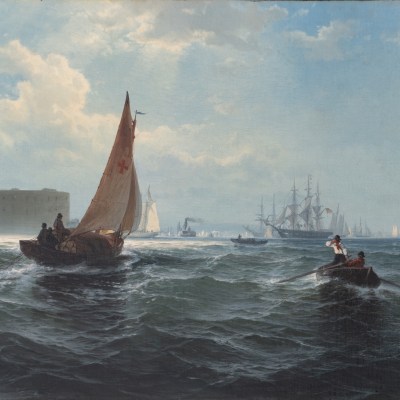
(1829–1901)
Born in Bolton, England, Edward Moran began his artistic career working in his family’s handloom weaving business. At the age of fifteen he immigrated with his family to the United States. They first settled in Maryland, where he worked at a large textile mill. By the time Moran was eighteen, he had moved to Philadelphia and was studying under marine painter James Hamilton. In 1854 Moran exhibited for the first time at the Pennsylvania Academy of the Fine Arts while he supported himself as a lithographer. In 1857 he opened a studio in New York City and was joined by his younger brother, renowned painter Thomas Moran, who later wrote: “[Edward] taught the rest of us Morans all we know about art and grounded us in the principles we have worked on all of our lives.”[1]
In 1862 Edward Moran traveled to London to study at the Royal Academy, where he encountered firsthand the works of J. M. W. Turner. Thereafter, Moran integrated Turner's sense of drama into his own paintings and depicted brilliant blue skies, turbulent green seas, and sublime atmospheric effects. By 1872 he had returned to the United States and settled permanently in New York City, painting tranquil harbor scenes rich in atmosphere. He devoted the last decade of his life to executing a series of thirteen paintings illustrating the important epochs in American marine history, which is now housed at the United States Naval Academy.
Moran exhibited regularly at the National Academy of Design and was elected an associate member in 1874. He also exhibited his work extensively at prestigious venues such as the Pennsylvania Academy of the Fine Arts, Brooklyn Art Association, The Metropolitan Museum of Art, and the Boston Art Club. In 1871 he showed seventy-five paintings in the Land and Sea exhibition held at James S. Earle and Sons Gallery, Philadelphia. His works are housed in private collections and important institutions, including the Denver Art Museum, Museum of Fine Arts, Boston; The Metropolitan Museum of Art, New York; Smithsonian American Art Museum and National Gallery of Art, Washington, D. C.; and the Philadelphia Museum of Art.
[1] Natalie Spassky, American Paintings in the Metropolitan Museum of Art, vol. 2 (New York: The Metropolitan Museum of Art, 1985), 309.
